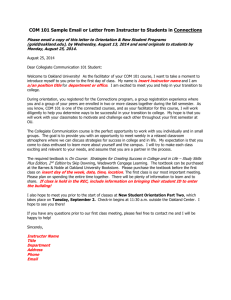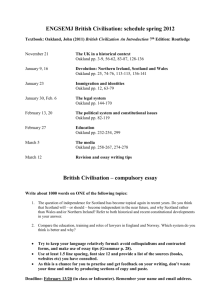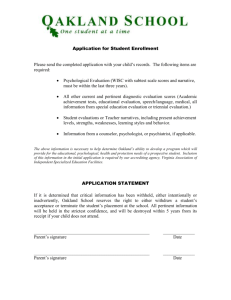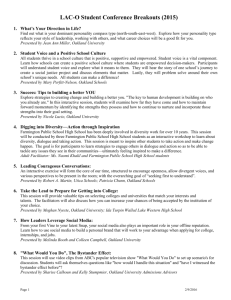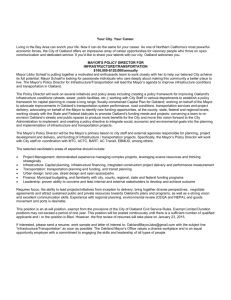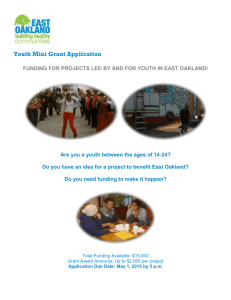11. Arnold-The myth of sustainability ORIGINAL 8-21-14
advertisement
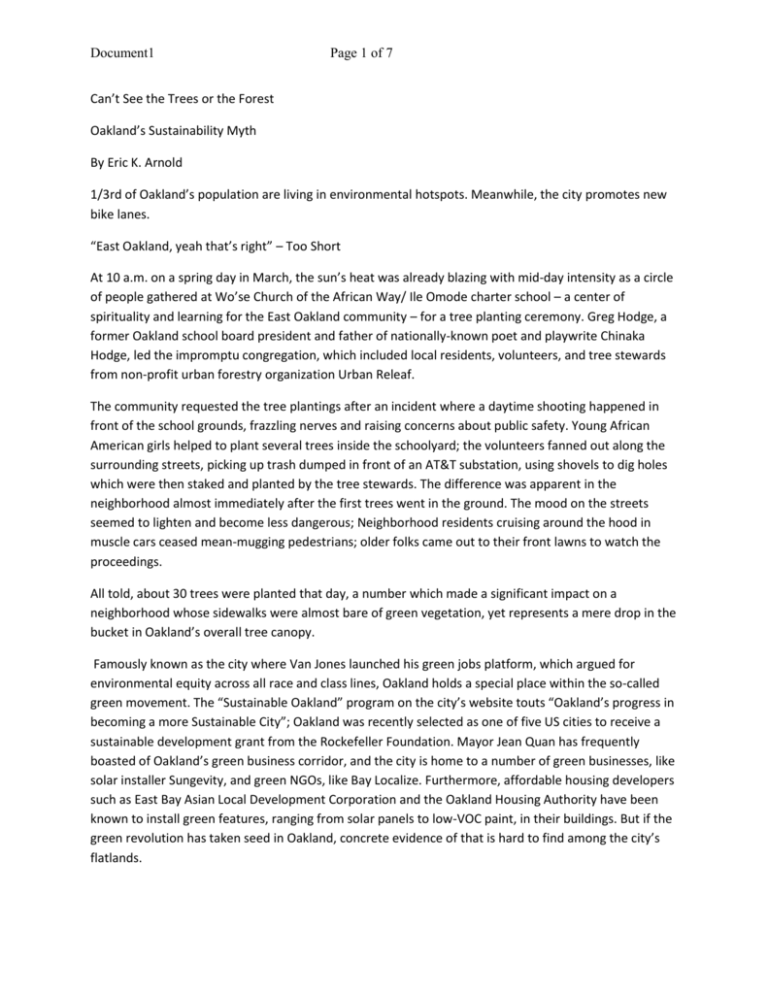
Document1 Page 1 of 7 Can’t See the Trees or the Forest Oakland’s Sustainability Myth By Eric K. Arnold 1/3rd of Oakland’s population are living in environmental hotspots. Meanwhile, the city promotes new bike lanes. “East Oakland, yeah that’s right” – Too Short At 10 a.m. on a spring day in March, the sun’s heat was already blazing with mid-day intensity as a circle of people gathered at Wo’se Church of the African Way/ Ile Omode charter school – a center of spirituality and learning for the East Oakland community – for a tree planting ceremony. Greg Hodge, a former Oakland school board president and father of nationally-known poet and playwrite Chinaka Hodge, led the impromptu congregation, which included local residents, volunteers, and tree stewards from non-profit urban forestry organization Urban Releaf. The community requested the tree plantings after an incident where a daytime shooting happened in front of the school grounds, frazzling nerves and raising concerns about public safety. Young African American girls helped to plant several trees inside the schoolyard; the volunteers fanned out along the surrounding streets, picking up trash dumped in front of an AT&T substation, using shovels to dig holes which were then staked and planted by the tree stewards. The difference was apparent in the neighborhood almost immediately after the first trees went in the ground. The mood on the streets seemed to lighten and become less dangerous; Neighborhood residents cruising around the hood in muscle cars ceased mean-mugging pedestrians; older folks came out to their front lawns to watch the proceedings. All told, about 30 trees were planted that day, a number which made a significant impact on a neighborhood whose sidewalks were almost bare of green vegetation, yet represents a mere drop in the bucket in Oakland’s overall tree canopy. Famously known as the city where Van Jones launched his green jobs platform, which argued for environmental equity across all race and class lines, Oakland holds a special place within the so-called green movement. The “Sustainable Oakland” program on the city’s website touts “Oakland’s progress in becoming a more Sustainable City”; Oakland was recently selected as one of five US cities to receive a sustainable development grant from the Rockefeller Foundation. Mayor Jean Quan has frequently boasted of Oakland’s green business corridor, and the city is home to a number of green businesses, like solar installer Sungevity, and green NGOs, like Bay Localize. Furthermore, affordable housing developers such as East Bay Asian Local Development Corporation and the Oakland Housing Authority have been known to install green features, ranging from solar panels to low-VOC paint, in their buildings. But if the green revolution has taken seed in Oakland, concrete evidence of that is hard to find among the city’s flatlands. Document1 Page 2 of 7 On Google Earth’s satellite map, the census tracts of the East Bay are revealed in three-dimensional images which show city streets as they actually appear. Examining them in detail reveals an interesting observation: the border between San Leandro and Oakland is clearly visible. The demarcation point, however, is identifiable not by any sort of landmark, but by tree canopy. East 14th St. runs through both cities; the Oakland side has been renamed International Blvd. On the San Leandro side of E. 14th, east of 109th Ave., bushy, adult trees line the sidewalks, next to grassy parks. The Oakland side tells a different story. Along International, there are practically zero trees, maybe one or two per block. East 14th St. is important because it runs all the way to downtown Oakland. It’s a busy transit corridor, one which runs parallel to the I-880 freeway and sees a considerable amount of vehicle traffic. It’s also one of the most polluted areas in terms of air quality in the entire state. Superimposing the Cal Enviroscreen map, which measures particulate waste matter, over the Google Earth map, reveals just how toxic the corridor actually is. E. 14th/International demarks a line separating the hills from the flatlands – areas where residents are typically low-income and predominantly people of color. On the Enviroscreen map, the areas above International are mostly shaded light yellow; the closer to the hills, the greener the map becomes. But below International, the colors range from orange (indicating a region within the top 20% of environmental pollution in the state) to red (within the top 10%). The entire length of International is within an orange zone, indicating extremely poor air quality. This environmental hotspot, which extends throughout East Oakland’s flatlands to the estuary and includes the Oakland International Airport, is home to a predominantly ethnic population of approximately 140,000 people, or more than one-third of Oakland residents. One red spot in particular stands out on the Enviroscreen map: Census tract 6001408800, an area surrounding the Eastmont Town Center (formerly the Eastmont Mall) -- a failed urban shopping center built in the ‘60s -- and later by a police substation built to discourage illegal sideshows, represents Oakland’s worst example of a high-pollution, low-income, community of color. The tract’s population is 46% Latino, 41% African-American, 8% Asian, and only 2% white. The area ranked in the 86th percentile for diesel emissions, the 75th percentile for toxic releases, the 95th percentile for cleanups, the 87th percentile for groundwater, the 81th percentile for hazardous waste, the 78th percentile for solid waste, and the 96th percentile for impervious water bodies. In terms of health impacts, census tract 600140880 was in the 99th percentile for asthma and low birth weight. The socioeconomic impacts were similarly disheartening: 93rd percentile for poverty and unemployment, 84th percentile for linguistic isolation, and 89th percentile for low education. As environmental advocacy organization Communities For a Better Environment noted in a 2010 study on diesel truck exhaust, East Oakland’s flatland communities are “disproportionately burdened by diesel pollution and have some of the highest cancer risks in the Bay Area.” The lack of tree canopy exacerbates these risks and not only subjects residents to greenhouse gas emissions, but also makes them more vulnerable to heat risk-related land cover (HRRLC), also known as the urban heat island effect. A heat island is an area where surface infrastructure, such as concrete and roofs, store and Document1 Page 3 of 7 reflect heat, resulting in higher temperatures in urban cities than rural areas – as much as 20 degrees Fahrenheit differential. According to a 2013 report [http://ehp.niehs.nih.gov/1205919/] published in Environmental Health Perspectives, “Impervious surfaces, such as asphalt and concrete, contribute to urban heat islands and surface temperatures via their high heat capacity, thermal conductivity, and often low reflectance of solar radiation.” The report goes on to note that 1 in 5 natural hazard deaths nationwide are due to HRRLC, which disproportionately impacts non-whites, and points out that “because of climate change, many cities are expected to become warmer,” as urban population centers grow denser. The urban heat island effect is at its worst in the summer, when overall energy demand increases, causing elevated levels of sulfur dioxide, nitrogen oxides, particulate matter, carbon monoxide, groundlevel ozone, acid rain, and carbon dioxide. This in turn can lead to negative health impacts including respiratory problems, exhaustion, and heat stroke. Flatlands such as East Oakland’s are particularly susceptible to heat island impacts, which include “increased energy consumption; elevated emissions of air pollutants and greenhouse gases; compromised human health and comfort; and impaired water quality,” according to the U.S. Environmental Protection Agency. For flatland residents, the combination of HRRLC and carbon emissions from vehicle traffic is a double whammy, which adds further injury to communities which already suffer from the highest rates of crime and the lowest levels of income. There’s one simple way to mitigate HRRLC, however: increase the tree canopy in urban areas. As the EHP study notes, “urban trees provide several environmental amenities”— ranging from shade on hot days, to wastewater reductions, to reduced air and noise pollution. Urban trees also have positive mental and physical health benefits, from reduced mortality rates to pregnancy outcomes. Because minorities in the United States tend to live in areas with sparse tree canopies, planting urban trees could significantly reduce the disproportionate environmental health impacts these demographics suffer. Environmental experts note that adding tree canopy to flatland areas is a preferred method of carbon sequestration. Planting trees also reduces the negative effects of the urban heat island effect. For that reason, urban forestry has been identified as one of five priority areas for greenhouse gas reduction by the state’s Air Resources Board, which monitors airborne pollutants. Under California’s groundbreaking 2006 environmental legislation, AB32, statewide standards for greenhouse gas reduction are now mandated by law. Further modifications since then have additionally stipulated that a portion of cap-and-trade funds collected under AB32 be directed at disadvantaged communities, i.e. low-income, high-pollution areas, also known as environmental justice communities (SB535); and that cities themselves are responsible for meeting the state’s mandated climate goals (AB375). Document1 Page 4 of 7 Given that much of Oakland’s flatlands are within the top 20th percentile of Cal Enviro-Screen’s pollution map, one might think that mitigation would be a top municipal priority. Indeed, urban forestry seems like a no-brainer for the diverse city of 400,000. Oakland’s current tree canopy stands at just 12-15%, according to the city’s Department of Public Works, far below the 40% threshold mandated by AB32. So it stands to reason “The Town” could surely benefit from an urban tree-planting initiative, similar to the ones done in Denver, Los Angeles, and other cities. Urban forestry experts estimate that between 750,000 and one million trees need to be planted to bring the city into compliance with statewide climate action goals. Yet the city of Oakland has been indifferent at best to urban forestry. The city’s Tree Services department doesn’t plant trees anymore, and refuses to contract out to local nonprofit groups who do this work. Assessing the needs of individual census tracts is impossible without an up to date tree inventory, yet Oakland last commissioned a study in 2006. Cal-FIRE officials say they gave the city $200,000 to update its tree inventory, yet the work was never done. Urban forestry isn’t the only potential carbon emission mitigation solution the city has neglected; in late 2012, the Oakland City Council ratified its Environmental Climate Action Plan (ECAP). Though the ECAP contained over 150 recommendations of best practices, only a few have been enacted. The city spent roughly $20 million to install bike lanes, but most other measures contained in the ECAP have gone unheeded. Staff turnover may have contributed to the inertia—the city’s Sustainability Director recently left his position—but you’d be hard-pressed to find an environmental advocate who has had an easy go at advancing a progressive eco-sustainability agenda within the city’s political maze. At a townhall meeting held August 12 called “Oakland: A Sustainable City,” mayor Jean Quan sat on a panel with a who’s-who of local green advocates: Nile Malloy, Northern California Program Director for Communities For a Better Environment; Bob Allen, Director of Transportation and Housing for Urban Habitat; Ginger Jul, Membership Manager for Bike East Bay; Miya Yoshitani, Executive Director for Asian Pacific Islander Environmental Network; and Al Weinrub, coordinator for the Local Clean Energy Alliance. The green-ribbon panel’s moderator was Chris Jackson, an up-and-comer in African American political circles whose environmental cred includes affiliations with the Sierra Club and the Alliance of Californians for Community Empowerment. The audience consisted of longtime residents and relative newcomers from all over the city. Sprinkled throughout the crowd were a handful of green stakeholders, including staffers at the city’s Sustainability Dept., and environmental justice advocates Margaret Gordon of West Oakland Environmental Indicators Project, Kemba Shakur of Urban Releaf, and Jumoke Hinton Hodge of the People’s Grocery. Quan began the proceedings by recounting the city’s numerous green initiatives, its pro-green business policies, and the proliferation of green non-profits. She repeated the claim made on the city’s website, that Oakland was one of “the greenest cities in the United States,” and talked up her environmental record in general terms, without delving too deep into specifics. Document1 Page 5 of 7 Lest anyone in attendance forget the mayor was running for reelection, attendees were handed out a list of her administrations’ claimed successes, which included adding over 30 miles of bike lanes, seeking funding for a bike share program similar to those found in European cities and Washington D.C., expanding urban farming in city-owned parks, supporting residential composting plans, and installing 30,000 LED lights, in every single one of the city’s streetlights. She proudly boasted about landing the Rockefeller Foundation “Sustainable City” grant. As one might expect from a seasoned politician, she managed to take credit for everything positive happening around green initiatives in Oakland, while also managing to avoid accentuating anything overly negative around the state of the environment. If not equally cheery, the advocates were for the most part relentlessly upbeat, as they gave quick bullet-point summaries of their issue areas. Malloy explained that the lack of an environmental health assessment for a planned crematorium in East Oakland spoke to the need for proactive “community review.” Allen calmly noted “resources for implementation are lacking” in the city’s climate action plan and spoke about the need to focus on community benefit in affordable housing and public transit. Yoshitani urged for an “equity lens” in economic development. Weinrub spoke of the push to expand community choice energy and make it more of a viable option in Oakland. But none of them openly disputed the efficacy of the mayor’s approach to sustainability. Had the meeting ended there, one might have walked away thinking that Oakland had no major environmental issues which couldn’t be easily solved, that everything was proceeding smoothly as far as developing an eco-friendly platform, and that the addition of bike lanes and adding 1700 affordable housing units in a three-year span was enough to guarantee a sustainable future for all of the city’s residents. During the audience Q&A portion, Mayor Quan was asked about her environmental mitigation strategy for East Oakland. Unfortunately, the mayor seemed unfamiliar with Enviroscreen and the implication of its data findings for Oakland. Instead of outlining a mitigation strategy which specifically addressed the East Oakland flatlands, she instead pointed to emission-reductions efforts in West Oakland. These include retrofitting diesel trucks and a new electrical power dock for container vessels at the Port of Oakland. “We’re trying to figure out the sources of the pollution,” she said, suggesting that much of East Oakland’s pollution came from the Port. Yet despite a 2012 UC Berkeley study which found a 50% reduction in diesel particulate matter at the Port of Oakland, and a new docking system which relies on electrical power instead of diesel fuel, Enviroscreen results suggest those efforts have had minimal impact on East Oakland’s flatlands. On the Enviroscreen 1.1 map, dated September 2013—subsequent to the UCB study—the 94601 area code, comprising a population area of more than 50,000 residents, ranked in the 91-95th percentile overall, with a diesel score in the 93rd percentile. The 94606 area code, comprising a population area of more than 36,000, ranked in the 91-95th percentile overall, with a diesel score in the 97.51th percentile. The 94621 area code, comprising a population area of almost 30,000, ranked in the 96-100th percentile overall, with a diesel score of 86.89. And the 94603 area code, comprising 31,000 people, also ranked in the 91-95th percentile overall, with a diesel score in the 89th percentile. Document1 Page 6 of 7 That might seem bad until you consider that overall Enviroscreen scores for East Oakland’s flatlands are better than a year ago, comprising a downward swing of approximately 5-10 percentage points across the board in some of the worst pollution hotspots. But statistics taken at face value can be misleading; the difference in Enviroscreen 1.1 and 2.0 ratings can be attributed to the more precise mapping of individual census tracts for Enviroscreen 2.0, rather than the more general zip codes for Enviroscreen 1.1. As the LA Times noted [http://www.latimes.com/science/la-me-0423-pollution-neighborhoods20140423-story.html#page=1], California has about 8,000 individual census tracts, compared to 1800 zip codes. That being the case, the state EPA’s claim that the 2.0 map represents “a finer level of resolution” suggests the lower scores for Oakland in 2014 are primarily the result of different methodology. Despite the mayor’s claims, it’s actually not that difficult to determine the sources of pollution in East Oakland, which is bisected by two highways and one freeway (I-580, I-880, CA-185) and a major thoroughfare (Int’l Blvd). Illegal dumping, the proliferation of brownfields, and the area’s numerous industrial sites are also recognizable sources of pollution. Expanding urban forestry could not only mitigate greenhouse gas emissions, heat-related hazards, and mortality associated with HRRLC, but also increase energy efficiency in flatland areas due to reduction in air conditioning and other energy costs associated with the urban heat island effect. Recent studies even suggest urban forestry can be part of an effective crime reduction strategy. And urban forestry can create green jobs for hard-to-employ and underemployed youth of color. Yet at the Oakland sustainability townhall, urban forestry was only briefly mentioned once, and none of the city’s many urban forestry experts were asked to participate in the panel discussion. The city’s apparent disinterest in promoting urban forestry could mean it misses out on much larger potential sources of funding environmental mitigation in its poorest, most toxic neighborhoods. At the Sustainable City townhall, mayor Quan mentioned seeking cap-and-trade funds under AB32 for affordable housing projects. Yet she made no mention of also seeking those funds for urban forestry projects, even though urban forestry was designated one of five priority areas under SB535, a bill which reserves 25% of the state’s Greenhouse Gas Reduction Fund for “disadvantaged communities,” i.e. those with the highest Enviroscreen scores. Of the $850 million in the GHGRF’s budget for this year, $225 million has been earmarked for what advocates call “environmental justice” communities. According to Cal-FIRE, the state allocation of GHGRF for urban forestry is expected to be around $18 million for FY 2014-15, projected at $30 million for FY 2015-16, and expected to increase significantly in years to come. An August 2014 bulletin by the governor’s office states the criteria for environmental justice communities to receive state funds under SB535: “Areas disproportionately affected by environmental pollution and other hazards that can lead to negative public health effects, exposure or environmental degradation; Areas with concentrations of people that are of low income, high unemployment, low levels of home ownership, high rent burden, sensitive populations, or low levels of educational attainment. Areas disproportionately affected by environmental pollution and other hazards that can lead to negative public health effects, exposure or environmental degradation; Areas with Document1 Page 7 of 7 concentrations of people that are of low income, high unemployment, low levels of home ownership, high rent burden, sensitive populations, or low levels of educational attainment.” To a T, that describes the East Oakland flatlands. Privately, many environmental advocates and some city officials acknowledge that Oakland’s dysfunction at the bureaucratic level has prevented it from truly being the model green city it touts itself as. “Oakland just doesn’t get it,” one prominent environmental advocate said, when asked why the city hasn’t made urban forestry a priority. But that dysfunction is contributing to the perpetuation of adverse health and environmental impacts for a large portion of its residents, the majority of whom happen to be living in communities of color.
